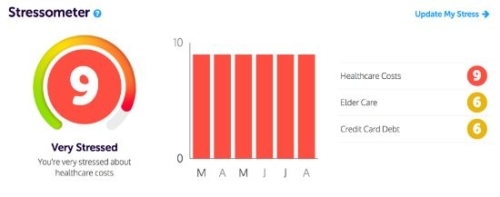
What Tops Financial Stress for Employees?
John Hancock released their annual Financial Stress Survey this week and the findings are worrisome. An overwhelming majority (69%) of American employees experience financial stress. Over 70 percent of them worry about personal finances at work (costing employers up to $2,000 annually per employee in lost productivity).
High levels of financial stress manifest through physical symptoms like anxiety, lack of sleep and a feeling of being overwhelmed. Nearly 90 percent of workers feel there is a social stigma associated with not being financially well, which could motivate them to conceal symptoms of financial stress.
Employers might not notice when employees are highly stressed about finances if they hide it well, and finances aren’t a topic employees are comfortable bringing up with their supervisors. Surveys like these give insight into how employers can better help employees by targeting the issues that affect them most through effective financial wellness programs and benefits.
What Tops Financial Stress for Employees?
Close to 80 percent of employed Americans are concerned about retirement savings and student loan debt. More than 60 percent of workers are concerned with keeping up with basic expenses, like monthly rent payments. Others are stressed about their overall financial situation and a lack of emergency savings.
Most Americans think getting financial advice at work would reduce their stress and more than 60 percent believe it would help them start saving more for retirement. Employees think employers can help them most with financial issues like retirement income preparation and Social Security and Medicare claiming. Roughly 30 percent think employers can help them with debt counseling or buying a house.
Employers recognize today’s American employees experience high levels of financial stress and are looking for ways to improve health and wellness offerings in this vital area. New solutions, like the creation of HRAs, and the rise of student loan benefits help employees deal with specific financial issues and have the potential to be incredibly successful in their respective areas. Their specificity is also a drawback. Employees in poor health or without student debt won’t benefit from those solutions, but they’ve surely got their own unique financial stressors.
Expansive financial wellness programs that give employees the tools and support to improve the issues affecting their overall financial wellness, versus those that tackle singular financial issues, are likely to make the most difference. Employees are able to reduce their financial stress by using and applying knowledge from their financial wellness program and eventually, will start to reach their financial goals.
More on Financial Stress and Financial Wellness Programs
5 Must-Have Benefits for Millennial Employees
How Does Financial Wellness Affect Health?
5 Fast Financial Stress Statistics
Hiring Trends to Watch in 2020
What Is Financial Literacy and Why Is It Important?
4 Big Employee Benefit Trends for Family Planning
How Can Financial Wellness Be Improved?
Top 10 Employee Benefits for 2020






